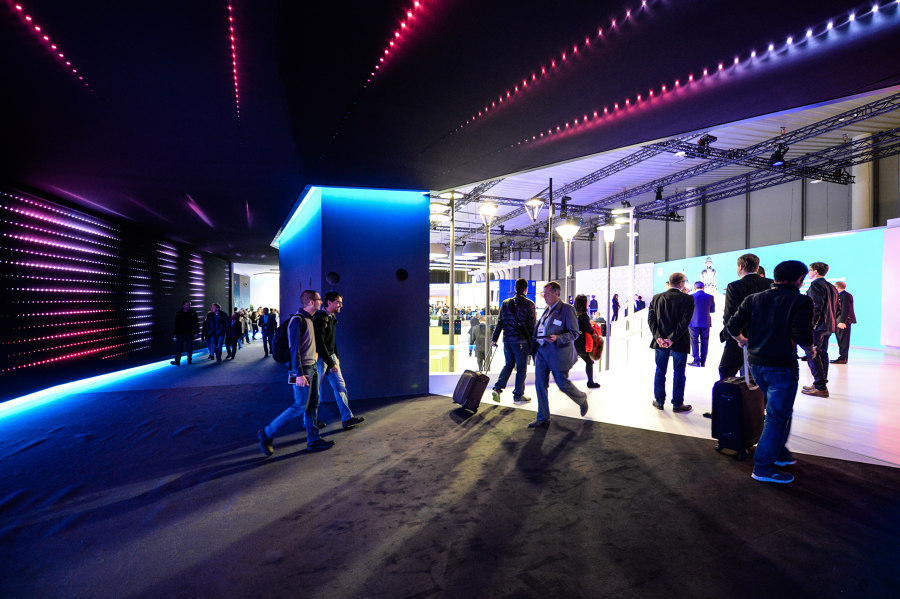Centre Stage for light
Texto por Light + Building
Frankfurt am Main, Alemania
20.01.20
It is also often nice if details stay invisible. Fully in accordance with the Bauhaus maxim – now a hundred years old.
Under this principle, architecture both inside and outside can be strengthened if form follows function. This effect is particularly visible when the subject is that of light. Therefore, along with the strategic employment of windows or light shafts, cleverly placed luminaires are more and more frequently also taking over the role of 'natural' light source. Already, thanks to highly efficient LED technology, almost bodiless, they often completely dispense with a shape of their own. The focus is on pure light.
Luminaires adapt themselves flexibly to the architecture of a building. Thus they emphasise the structural or design features with their light, without the lamp body being dominant. Source: Messe Frankfurt │ Pietro Sutera

Luminaires adapt themselves flexibly to the architecture of a building. Thus they emphasise the structural or design features with their light, without the lamp body being dominant. Source: Messe Frankfurt │ Pietro Sutera
×This aesthetic theory of light fulfils individual needs not just in private spaces. Functional luminaires are relevant particularly in the working environment. That is to say, wherever personal wellbeing has a direct impact on a worker's performance. Thus constant mental concentration under conditions similar to daylight is significantly easier than under pulsating neon tubes or in offices with the character of a darkroom. Plus the fact that contemporary lighting technology can be easily adapted to changes in overall general conditions. In a hospital, for instance, variable shades of lighting may promote significantly reduced recovery times. Blue tones excite, while red tones have a calming effect. The name of the technology: human-centric lighting.
Scenarios of calming red-spectrum to exciting blue-spectrum light support our biorhythm. Functional aesthetics in light design is a topic at Light + Building 2020. Source: Messe Frankfurt │ Pietro Sutera

Scenarios of calming red-spectrum to exciting blue-spectrum light support our biorhythm. Functional aesthetics in light design is a topic at Light + Building 2020. Source: Messe Frankfurt │ Pietro Sutera
×But functional-aesthetic luminaires are popular as a design element, too. Light has the ability not only to show formal language, but to support it. Position, intensity, angle of beam, spectrum of light – all these are factors which make the particular attribute of the building or interior into something which can be experienced. This effect is only unbroken, though, if the lamp itself does not attract too much attention to itself. A further stylistic advantage is the new flexibility of this species of lamp. The light portfolio is so large that in one and the same room scenarios are possible which imitate glittering sunlight just as successfully as huge sunsets or powdery aerial mist.
Along with the strategic employment of windows or light shafts, cleverly placed luminaires also are more and more frequently taking over the role of light source. Source: Messe Frankfurt │ Pietro Sutera

Along with the strategic employment of windows or light shafts, cleverly placed luminaires also are more and more frequently taking over the role of light source. Source: Messe Frankfurt │ Pietro Sutera
×Under the top theme of 'Fascinating', Light + Building 2020 will be staging a series of light and lamp design themes. These will include 'functional aesthetics.' This theme will focus on luminaires which stay in the background to the benefit of the light itself.
The 'functional aesthetics' theme at Light + Building will be about using light to emphasise both architecture and building use. Source: Messe Frankfurt │ Pietro Sutera

The 'functional aesthetics' theme at Light + Building will be about using light to emphasise both architecture and building use. Source: Messe Frankfurt │ Pietro Sutera
×From 8 to 13 March 2020, Light + Building will form an international light spot for architects, interior designers and planners, among others. Along with design, networking and thus the digitalisation of light – as a dynamic element within the intelligent building – will play a central role.
Luminaires which themselves withdraw into the visual background, to allow prominence to the light, will be part of the theme of 'functional aesthetics' at Light + Building 2020 in Frankfurt am Main. Source: Messe Frankfurt │ Pietro Sutera

Luminaires which themselves withdraw into the visual background, to allow prominence to the light, will be part of the theme of 'functional aesthetics' at Light + Building 2020 in Frankfurt am Main. Source: Messe Frankfurt │ Pietro Sutera
×This trend can also be seen at first hand at the special area of ZVEI. There one of the hot topics is LaaS – Light as a Service. Here the ZVEI will be demonstrating the efficacy of services in the lighting sector. LaaS makes light into a service asset, in the way that rental vehicles, leased printers or rented offices already are. In this way in particular lighting providers can open up a secondary line of sales revenue vis-a-vis professional clients. The area at Light + Building 2020 will have a representative space in Hall 3.0 at the Frankfurt Fair and Exhibition Centre.
At the same time, Light + Building will be presenting its Trend Forum in Hall 6.2. For this show Stilbüro bora.herke.palmisano, as commissioned by the leading international trade fair, has been researching shapes, colours and materials all over the world, which will excite consumers in future. In the Trend Forum the style analysts will be arranging the future of living in three scenarios – 'Organic Sculptures', 'Studied Masterpieces' and 'Inventive Collages.'





